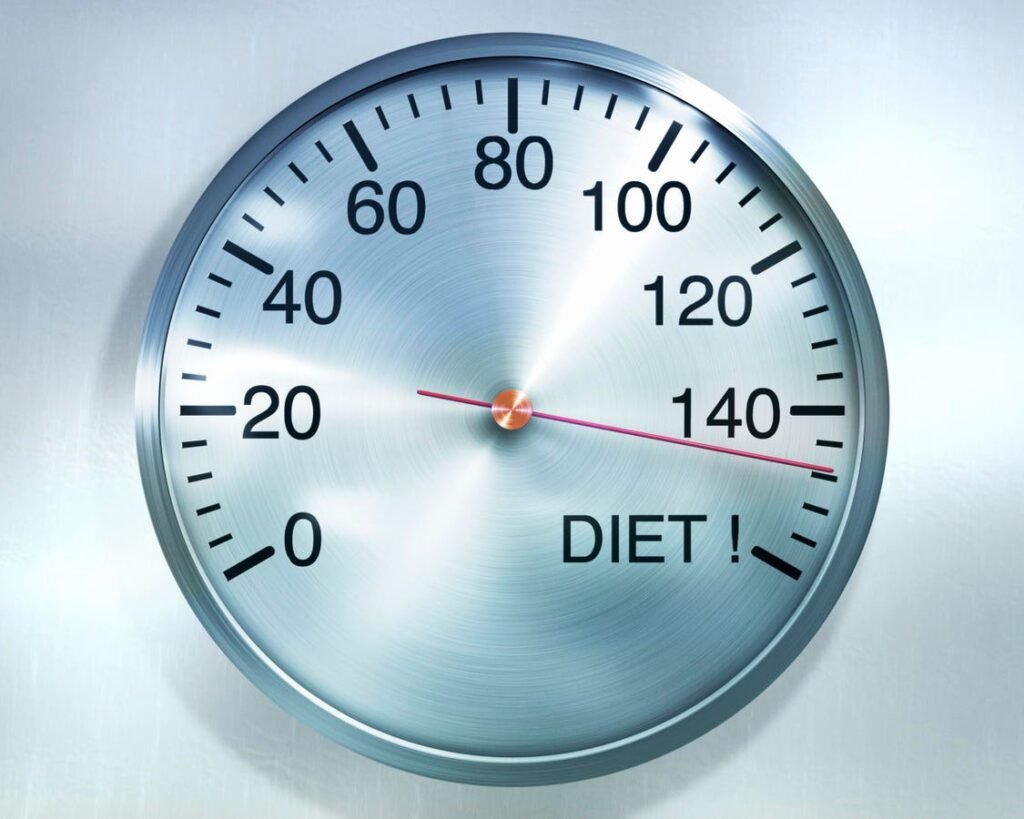As time goes on, your defended weight range may gradually shift upward due to hormonal, metabolic, environmental, and microbiome-driven changes that push your body towards a higher weight.
Many people wonder why weight gain seems effortless while weight loss feels like an uphill battle. In the first two parts of this Forbes Health series, we delved into the short-term appetite system that regulates hunger and fullness, followed by the long-term regulatory network that defends your natural weight range.
This third installment addresses a crucial question for modern life: why the body’s defended weight range continues to increase over time. While some may attribute weight gain to excessive calorie intake or lack of discipline, the reality is that biological adaptations to the environment play a significant role in driving the body towards a higher weight.
To understand why the defended weight range rises, we first need to explore the biological mechanisms that cause the set point to drift upward, and then identify the major triggers that set these mechanisms in motion.
The Set Point Doesn’t Just Defend. It Can Also Drift Upward
Warning on weight scale.
getty
The body weight set point is often viewed as a fixed target, but research indicates it behaves more like a defended range that can be readjusted. When strong signals consistently push the system upward, the brain starts defending a higher level of stored energy.
This drift is not random; it reflects adaptive responses to chronic stress, dietary habits, inflammation, sleep disturbances, changes in the microbiome, and shifts in endocrine function. In evolutionary terms, these signals mimicked environments where food scarcity was a possibility. In today’s world of abundance, however, they can lead the body to maintain a weight that is higher than what is optimal for long-term health.
The Physiological Pathways That Drive the Defended Weight Range Upward
Several biological mechanisms contribute to this upward drift, with the most significant ones outlined below. These represent the core physiological pathways that recalibrate the defended weight range, leading the body to protect a higher weight as its new norm.
1. Leptin Resistance: When the Brain Stops Responding to “Enough”
As body fat increases, leptin levels rise in the blood, signaling the hypothalamus that energy stores are sufficient. Leptin typically acts on POMC neurons to promote fullness and suppresses AgRP neurons that stimulate hunger, providing the brain with a continuous signal that energy stores are satisfactory. However, with chronic overnutrition or inflammation, the brain becomes less sensitive to leptin, a phenomenon known as leptin resistance, as detailed in a 2012 Cell Metabolism review by Myers and colleagues.
Think of the body’s fat stores as a fuel tank. Leptin serves as the gauge signal that rises as the tank fills. The hypothalamus is the system that interprets that signal. With leptin resistance, the hypothalamus misinterprets the gauge and assumes fuel is low even when the tank is full, initiating a series of events that push the body towards storing more fuel.
When leptin signaling is blunted:
- The brain perceives “low fuel” even when stores are high
- Hunger increases
- Satiety weakens
- The defended weight range shifts upward
Leptin resistance significantly contributes to the upward drift in the set point by removing a crucial brake on appetite and energy balance. Even minor disruptions in leptin signaling can alter how the brain perceives stored fat, prompting it to defend a higher weight as its new baseline.
2. Insulin Resistance: The Weakening of Satiety Signals and the Shift in Energy Balance
Insulin is primarily known for regulating blood sugar levels, but it also plays a vital role in appetite control. When insulin reaches the hypothalamus, it acts on POMC neurons to promote fullness and helps suppress AgRP neurons that stimulate hunger. This signaling reduces appetite and supports normal energy balance by indicating that fuel has been delivered to tissues.
When insulin signaling in the brain becomes impaired, these pathways weaken. POMC neurons are not as effectively activated, AgRP neurons are not as effectively suppressed, and the overall satiety response diminishes. As insulin’s influence on these neurons weakens, a set of downstream metabolic levers shift in favor of weight gain. Fat storage increases, energy expenditure decreases, and the body becomes more proficient at retaining calories, creating an energy balance that favors weight gain. Research by Gower and Goss in Current Opinion in Endocrinology, Diabetes and Obesity describes how this diminished insulin response can raise the defended weight range and make weight gain more likely.
Central insulin resistance often develops alongside leptin resistance. When both pathways are affected, the brain struggles to recognize that energy stores are sufficient. This dual impairment is a consistent finding in obesity research and directly contributes to the upward drift in set point.
If leptin is the fuel gauge, insulin serves as the signal that fuel is entering the tank. As insulin resistance develops, this incoming fuel signal weakens and becomes inconsistent, causing the brain to act as if the low-fuel warning light never turns off even after adequate fuel has been delivered.
3. Hormonal Imbalance in Appetite and Energy Regulation
Appetite and energy regulation rely on a coordinated network of hormones that communicate with the brain to maintain a balance between fuel intake and fuel utilization. This system includes leptin and insulin, as previously discussed, along with ghrelin, GLP-1, peptide YY, and other gut-derived hormones that regulate hunger and fullness from meal to meal. Cortisol and thyroid hormones also influence metabolic rate and how the body responds to changes in fuel availability.
In a healthy system, these hormones fluctuate in predictable patterns. Ghrelin rises before meals and falls after, while GLP-1 and peptide YY increase during eating to promote fullness. Cortisol and thyroid hormones support consistent energy utilization throughout the day. Together, these signals inform the brain when to seek food, when to stop eating, and how to apportion energy between storage and expenditure.
These disruptions differ from leptin and insulin resistance, which stem from reduced sensitivity in the hypothalamus. In this scenario, the issue often originates at the source when the gut, pancreas, adrenal glands, or thyroid release these hormones in abnormal patterns. This irregular timing or production distorts the signals the brain receives. Ghrelin may be overproduced, and satiety hormones like GLP-1 and peptide YY may not be released adequately. Cortisol might be elevated at inappropriate times of day, and thyroid hormones may not support typical metabolic function.
As this imbalance persists, hunger increases, fullness weakens, and the body becomes more inclined to conserve energy rather than expend it. These shifts contribute to a gradual increase in the defended weight range.
4. Microbiome Shifts That Alter Appetite and Energy Harvest
Human microbiome microbes.
getty
The gut microbiome plays a crucial role in appetite regulation, inflammatory balance, energy extraction, and communication between the gut and brain. The trillions of microbes residing in the intestine help break down nutrients, produce signaling molecules that influence satiety, and determine how much energy the body absorbs from food. Even minor alterations in microbial composition can impact these processes in ways that encourage weight gain.
In a healthy state, the microbiome generates short-chain fatty acids like butyrate, acetate, and propionate. These compounds help maintain the intestinal barrier, reduce inflammation, and stimulate the release of GLP-1 and peptide YY, two hormones that enhance satiety. Beneficial bacterial families such as Bacteroidetes and Christensenellaceae are often linked to lean metabolic profiles and efficient appetite regulation.
When the microbiome becomes imbalanced, several physiological pathways begin working against weight control. Certain strains increase calorie extraction from the same amount of food. Others decrease the production of short-chain fatty acids, compromising the hormones that typically signal the end of a meal. An uptick in more inflammatory species, often accompanied by a higher Firmicutes-to-Bacteroidetes ratio, can heighten gut permeability and elevate inflammatory signaling. This contributes to both leptin and insulin resistance and disrupts the gut–brain communication that aids in regulating hunger and fullness.
These microbial changes also impact reward pathways and cravings. A decrease in beneficial metabolite production can alter dopamine signaling, making highly processed foods more appealing. This reinforcement of eating patterns that encourage weight gain supports a higher defended weight range.
These concepts were elaborated on in more depth in my recent Forbes Health article on the microbiome, which explored how specific microbial patterns influence appetite, energy extraction, inflammation, and metabolic wellness.
5. Epigenetic Changes That Lock In Weight-Promoting Biology
Structure of a chromosome. Epigenetic mechanism.
getty
Epigenetics involves chemical marks on DNA and chromatin structures that package it. These marks influence which genes related to appetite regulation, fat storage, insulin sensitivity, inflammation, and reward signaling are activated or suppressed. As these marks dictate how cells interpret hormonal and metabolic signals, epigenetic patterns play a significant role in long-term weight control.
One of the primary epigenetic mechanisms is DNA methylation. Adding methyl groups to specific chromatin regions causes the structure to become more tightly packed. This condensed chromatin structure prevents certain genes from being expressed, effectively silencing genes involved in appetite regulation, insulin sensitivity, thermogenesis, or fat storage.
In a healthy scenario, epigenetic marks remain flexible. Genes that support fullness, mitochondrial function, and energy utilization can adjust their activity based on changing metabolic demands. When unfavorable epigenetic marks accumulate, this flexibility is lost. Genes that guard against weight gain may be silenced, while those that promote fat storage or diminish appetite control may become more active. These changes can impact how the brain responds to hunger signals, how effectively cells utilize energy, and how rigorously the body defends its current weight.
This concept is supported by research across species, including studies highlighted in the New England Journal of Medicine, which discussed how epigenetic marks influenced feeding behavior, energy balance, and metabolic traits across generations in fruit fly models. These findings underscore that epigenetic changes can have enduring effects on weight biology, even when environmental conditions improve.
Once these patterns are established, they can persist for extended periods, creating a physiological environment that favors increased appetite, reduced energy expenditure, and greater metabolic efficiency. This hinders the body’s ability to lower its defended weight range and explains why weight regain is common despite consistent lifestyle modifications.
While epigenetic patterns are not fixed and can be altered over time, they contribute to the strong biological inclination many individuals experience towards a higher weight. Recognizing this role helps clarify why some people require more targeted and sustained interventions to shift long-term metabolic pathways.
6. Reward Pathway Dysregulation in the Brain
The brain’s reward system plays a central role in shaping food preferences, cravings, and the motivation to eat. Foods that are highly palatable, containing sugar, fat, and salt, stimulate dopamine pathways in the brain’s reward centers. These circuits are designed to reinforce behaviors that ensure survival, such as seeking out calorie-rich foods when they were scarce.
With repeated exposure to calorie-dense foods, these dopamine pathways can become desensitized. The brain releases less dopamine in response to the same stimuli, diminishing the reward response. Consequently, individuals may require larger portions or more intensely flavored foods to achieve the same level of satisfaction. Satiety hormones lose their influence over eating behavior as the reward drive begins to override the physiological cues that typically signal the end of a meal.
This dysregulation also impacts the prefrontal cortex’s ability to modulate impulse control and decision-making related to food. Reduced dopamine signaling can weaken the brain’s capacity to weigh long-term goals against short-term rewards, making it harder to resist highly palatable foods even when hunger is not high. Over time, this pattern increases food intake, alters eating habits, and reinforces neural circuits that favor energy-dense foods.
These changes interact with other physiological pathways. Reduced dopamine signaling diminishes the effectiveness of signals from leptin, insulin, GLP-1, and peptide YY, which typically promote fullness. As reward pathways take precedence, the brain becomes less responsive to hormonal cues indicating sufficient energy stores.
This shift in the reward system creates a biological environment that encourages overeating and supports a higher defended weight range. The body becomes more inclined to sustain behaviors and intake patterns that drove the elevated reward drive, even when these patterns no longer align with true energy requirements.
7. Reduced Thermogenesis and Impaired Mitochondrial Efficiency
Thermogenesis refers to the body’s ability to generate heat by burning calories, playing a crucial role in long-term energy balance. Brown and beige fat cells, along with mitochondria within muscle tissue, regulate the balance between energy utilization and storage. These systems respond to hormones like leptin, insulin, thyroid hormones, and catecholamines to adjust metabolic rate throughout the day.
As the defended weight range increases, these thermogenic pathways often become less active. Mitochondria may not respond as effectively to hormonal signals that typically promote energy utilization, and brown fat activity can decrease. This results in a lower resting metabolic rate and reduced capacity to boost energy expenditure after meals or during physical activity.
This decrease in thermogenesis creates a more energy-efficient state that favors weight gain. Fewer calories are burned during daily activities, leading to more significant fat storage. Over time, this metabolic adaptation stabilizes the higher defended weight range, making it challenging for the body to return to lower levels of energy expenditure.
Triggers That Activate These Pathways
The mechanisms described above do not shift independently; they are activated and accelerated by common pressures in modern life. These factors do not directly raise the defended weight range; instead, they distort hunger signals, impair metabolic pathways, weaken satiety, or increase inflammatory activity, driving the upward drift in set point.
Crucially, these influences vary from person to person


